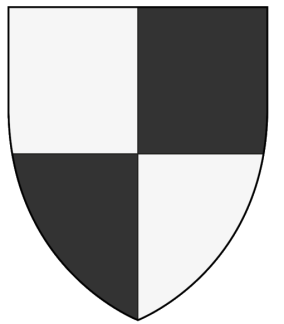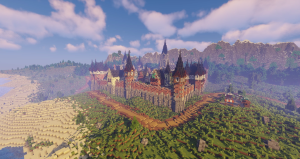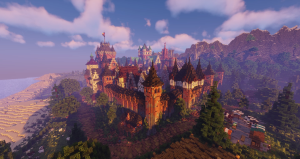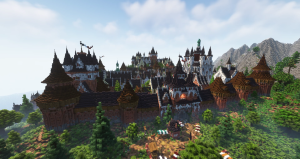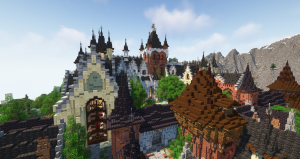Adelsburg
| Nicknames | The Iron Bastion, The Imperial Jewel |
| Country | The Hadrian Empire |
| Founded | Founded in 1522 by Roderick Withmond |
| Governing
Body |
The Imperial Diet
The Imperial Council |
| Kaiser
Kaiserin |
Diederick-Gobel von Lichtenfelts |
| Bürgermeister | Friederich von Bergwald-Holstein |
| Vater | Vater Gregor I |
| Language(s): | Common, Attian dialect |
Adelsburg
The Imperial Capital of Adelsburg, better known as der Reichshaubtstad Adelsburg in low-Attian, is the Capital and largest city of the Hadrian Empire. It is located in the Grand Principality of Brandenhafen, with the spine of Eden’s western branch to its north, and the Al’Hadar deep to its south.
Founding
Founded by King Roderick Withmond in the year 1522, the city of Adelsburg has stood strong as the beacon of humanity ever since. To date, the city mostly houses a large population of Attians, and a decently sized Hinterlander minority also settled within its walls.
Evolution of Adelsburg
These walls, which tower over the forests that surround the city can often be spotted from miles away. Originally, they were constructed as a simple barricade consisting of battlements and sparse towers. Yet this fortification, designed with only a primitive understanding of the coastal region it was built in, quickly fell into decay. This occurred chiefly on the southern side of the city, where the soil was much looser the closer you stepped toward the beach. Hence, during the reign of Kaiser Philipp Wilhelm II, a revision of the city walls was ordered. Whilst the north, east, and west sides needed only to be strengthened, the south side had to be rebuilt as a whole. This time more attention was placed into a proper foundation. This rework also saw the addition of wooden ramparts to the city walls, an early prototype that would soon be used throughout the entire Empire.
Yet it was during Kaiser Diederick-Göbel von Lichtenfelts' reign that the Imperial Capital saw its biggest and most impactful changes. Soon after Kaiser Diederick ascended the throne he ordered the most esteemed architects he had gathered, to sit down at their drawing tables to redesign the city that had fallen into decay due to the poor ruling of the Supreme Chancellor.
Under Sine Verradors reign the city had been left to rot and decay. Homes were pillaged and temples defiled. There was nothing left of the gem of the west. The Usurper had the Temple of Alder fully stripped of its riches on the inside, no bench nor statue or had been left untouched. The widely popular and famous tavern had its colorful artworks and banners discarded, its silverware stolen and its workers killed. The streets were in ruin, as buildings, or what was left of them, crumbled, and nature slowly started to take over. Threatening to destroy the city and its legacy once and for all.
“I made my way inside and what I found was a pillaged and empty place that was once the seat of the holy imperial crown.
As I entered the throne room I saw the carpet still stained with the dry blood of those who stood to protect their home and liege”.
- Diederick-Göbel von Lichtenfelts after capturing Adelsburg, 1534
After a devastating reign of Predecessor Sine, a rebuild was swiftly agreed upon and scheduled to begin in 1534. Construction began with a new Imperial Palace, one that would tower over the city, marking a new age for all Hadrians and its architecture. Soon after, the walls of Adelsburg were torn down ready to be reconstructed from the ground up from its ruins. Yet this time bigger, stronger, and taller than ever before. The architects had taken the original design of a brick wall with wooden ramparts and refined it. Not only did they make the walls taller to increase the sightline of the archers that would man the ramparts, but they also added another level in the wall itself, with additional arrow slits that offer sightlines closer to the wall itself, making it nearly impossible for a besieger to get close.
Additionally, towers had been radically redesigned. Most towers appear as an extrusion on the wall, these extrusions that can be seen every approximately 100 meters are slightly taller than the wall itself and offer three levels of archery positions instead of two. On the four corners of the city, large round towers were placed that, like those extrusions, offer three layers of archery positions that have a 90-degree view of their surroundings.
Additionally, this new and improved city wall also meant a drastic redesign of its gatehouses was needed. The eastern gatehouse, the Kaiser’s Tor, was swiftly torn down, and its materials were used to construct its replacement. Though grander, and generally larger in size, much of the old design, which consisted of 4 diorite towers in a square formation was carried over into the current rendition, Once completed a drawbridge was added, to provide additional protection. On the south side, the then dormant and barely used southern gate, the Schadel Tor, was changed into a large diorite tower, this tower would be connected to a drawbridge, which would eventually be connected to the port.
Yet, before this port, which until then had consisted of only a few buildings, could be constructed, it was up to the architects and workers of the Hadrian Empire to finish everything within the city walls. As plans were made for reconstruction within city walls, chroniclers of the Empire delved into the archives to find descriptions of the city as it had been in the past.
First rendition (1522 - 1525)
In the first rendition of Adelsburg, founded by Roderick Withmond, the city mostly revolved around a major street that cut the city in half, a northern and southern district. On the south side of this street, the tavern of the legendary Boris Krüger could be found, as well as tall townhouses that mostly consisted of stepped gable facades, directly opposite this street stood the temple, a rather long diorite building with a protruding clocktower standing tall. Adjacent to the east of this temple was the school, within close proximity to the city stables. Further westbound, the southern city wall was connected to a larger building that had a small courtyard for military purposes, this west side of the city also housed the largest building of Adelsburg, a large council building that consisted of four small towers, each on every corner, and a large though not very tall tower sticking out it’s middle.
Second rendition (1525 - 1534)
The second rendition of Adelsburg was ordered under Kaiser Philipp Wilhelm II, who after the revision of the walls and the addition of the ramparts, noticed a sudden growth of the Hadrian populace. The Hadrian Empire desired a greater capital, and so, plans were made. At the time, these plans felt ground-breaking. It appeared as if a whole new city was to be built, yet in reality, all that happened was a form of upgrading. As stated before, the wall had already been taken care of before the construction of the city inside those walls began. Most of the layout of the previous city was kept intact. The military courtyard remained in the same position, yet was expanded into a military fort of a decent size. Additionally, the gatehouse that parted the city in half, city stables, and temple also remained in the same location. Of the buildings that remained, it was the temple that saw the biggest change, especially in external appearance. Most of the temple's interior remained the same, while the outside was changed to brick. Not only was the exterior changed to brick, but it also had its one sole tower torn down, and replaced for a larger facade. This grand facade within it a beautifully adorned stained glass art piece, had one spire protruding on the left of it, while the right side remained flattened. Adjacent to the temple was still the school building, though now swapped from the eastern side to the west.
The temple sat in the same location as the previous one, though the area in front of it had been transfigured. Instead of a street that passed straight in front of it, the city now had its first city square. This square was surrounded by the facades of the many shops that Adelsburg owned, as well as the Imperial Library and the Adelsburg Tavern. Finally, after all that construction had been completed it was time for the soon-to-be crown jewel of the Imperial Capital, the Imperial Palace.
Located on the far north-west corner of the city the first Imperial Palace stood tall over the many smokestacks that filled the skyline. With a grand living tower rising from its middle it offered a great view over the city and the vast lands around it. Its grand halls served the nobility well, and many a feast was held there. At least, until the untimely assassination of Kaiser Philipp Wilhelm II in 1532, after which it fell into a quick decay under the rule of Sine Verrador.
Third rendition (1534 - Current)
Things bring us back to the third rendition, which as previously mentioned started with the build of an even grander Imperial Palace. At the end of Philipps rule, he had grown unhappy with the result the construction of his palace brought forward. The then Kaiser had new blueprints drawn up and the Hadrian stonemasons had been ordered to start their work. They refused, unhappy with the immediate rebuild of the former palace that had not been completed long ago, they went on strike. This strike lasted briefly until Philipp untimely passed away, after which the plans were decommissioned by his usurper Sine Verrador.
However, Kaiser Diederick stumbled upon the plans for the new palace and immediately ordered its construction, as well as the deconstruction and upgrading of the city walls as previously mentioned. However, the rebuilding of the city that had fallen into decay would not be limited to such. Radical changes were going to be made. Instead of a long central street a square formed behind the main gate. This square, known as Wyatts Platz, acts as a buffer to the rest of the city during times of sieges and houses a smith, the Bergwald-Holstein brewery, and a gate towards the military area of the capital.
Once on the Wyatts Platz, there are two possible directions of travel. Whereas one leads to the military area, the other leads deeper into the city. This military quarter, south of the square, had been totally relocated in relation to the second rendition. The castle that houses the Reichsarmee was deconstructed and is now moved towards the southeast corner of the city wall. This brick castle, which protrudes above the wall with four large corner towers, is strategically placed in between both gates, offering great additional protection to one of the most vulnerable areas of the city, as well as extra protection to the adjacent diet hall. Following the other street that goes west from Wyatts Platz through a gate below the tavern. One would make it onto the grand square of the Imperial Capital. Philipps Platz as it’s called, is the largest square of the Imperial Capital and the heart of the city. Adjacent to this square are large townhouses that carry an uncanny resemblance to the old step-gabled facades of the first and second Adelsburg renditions. In these townhouses that encircle Philipps square one is most likely to find shops, as well as the hospital, bank, tavern, and library. From this square, there are yet another two directions of travel, north and south.
On the northern side, there is a large bronze statue of Alder Himmelschwert on horseback, this statue stands tall in front of the Grand Temple of Alder which is roughly located in the same spot as the previous temple renditions. Reached by having to scale a few steps, the current temple stands tall over all other buildings in the capital, except for the Imperial Palace. This large diorite building consists of a large main dome, with eight towers around it. On the top of the dome is another statue of Alder, this time one where he is portrayed standing, with his sword towards the sky. Furthermore,, there is not much of worth in the north side of Adelsburg, except for the Temple Quarters east of the temple, which include the Vater's residence, clergy buildings, and the entry to the Imperial crypts.
Going back to Philipps Platz, past the large statue of Alder, and the statue of Kaiser Philipp Wilhelm II there is a street to the south. This street, with on its left the taverns garden, and on its right the Imperial Bank and library, connects Philipps Platz to a square named after his son, Karl Philipp I von Lichtenfelts. Karls Platz is mostly surrounded by regular residential townhouses, except for two buildings. These are the Imperial University of Adelsburg and the Bürgermeisters office, the latter being located above the second gateway that leads out of the south side of the city.
Furthermore, there are a few gates that connect the eastern side of the city, which consists of Wyatt Square, Karls Square, and Philipps Square with the west side of the city. Whilst the east of the city mainly consists of shop fronts and other places for craftsmanship the west is almost only residential. The only thing that is noteworthy in this part of the city is the road that connects the city to the gates of the Imperial Palace.
After the construction of all of this was completed, the last addition to the Imperial Capital was added. Traveling south through the gate below the Bürgermeisters office leads to the Imperial Port. This port, which is the largest of the Empire, is the main area of import and export and the Imperial center of trade.
Besides the usual docks, workshops, and port houses there is one building that stands out, a massive crane and storage tower of brick, that stands tall over all other buildings in the port.
Historic Events
The Imperial capital has not only been home to the many residents it has had over the years. It has also proven itself to be quite the theatre for spectacle. Over the years many great historical events have taken place in der Reichshaubtstad, some more important than others. The first major event that took place in the then-recently completed Adelsburg was the assassination of former King Roderick Withmond.
Assassination of Roderick Withmond (1522)
Roderick had already been asked by Vivan De Augaussi to lay down his throne and rule in 1522, and had done so. He had given up his rule and instead took the position of Herzog of Hadriana, the town now known as Norbüren. Yet Vivan was unhappy with his rule of Hertzland province as he got word that Roderick had planned to give out crucial information to Veronia's enemy Wakkerdam. King Vivan swiftly responded to these rumors by inviting Roderick Withmond to a council meeting in the large council building that stood on the west side of Adelsburg. Roderick happily took the invitation as he rode onwards to the capital. Once he arrived he moved into the council room, where he was met by King Vivan de Augaussi, Queen Wendelin de Augaussi, and some of their loyal servants. A fight ensued as the usurpers tried to end the life of Herzog, yet it was Roderick who managed to escape by jumping through a window. This however proved a leap too far for the fallen King. Once he jumped he landed on the cold hard street below, only to be finished by Vivan with a slow deep stab to his heart.
The short rule & sudden death of Matthias (1524-1525)
A few years passed, during which King Vivan and his wife, Queen Wendelin, got lost in the swamps of old Attia. The loss of the King and Queen created a power vacuum, in which the Hadrian people longed for a new leader. Matthias Joseph Withmond would be the chosen one. After his appointment, it was the young man who managed to bring the shattered human lands together. Under the newly united Hadrian Empire, the rule of Matthias was one of peace and growing unity. Though this upcoming new age for the empire would be brutally disrupted after only three hundred days as one day, Matthias opened his eyes and found himself terribly weakened without any clear explanation as to why and was swiftly bedridden. The only one allowed by the Emperor’s side during these days was a young prince and ward from the old von Lichtenfelts dynasty, Philipp. The people of the Empire prayed to Alder and Mortius to spare the young Emperor yet behind closed doors, Matthias’ condition only worsened, eventually making it clear to all around him that the new young Emperor would die childless and incredibly soon. It was only when Matthias himself realized this that he turned to Philipp and according to Philipp named him heir of the Hadrian Empire. Matthias would die peacefully two nights later. He was buried after a week of mourning in the Grand Temple of Alder in Adelsburg. His body remains in the Adelsburg crypts to this day.
Arnoud's Trial (1526)
Matthias had just passed away when the Hadrian Empire was met with yet another problem. Arnoud van Leuveren, Herzog of Wakkerdam had been to the Luminion court where he had thrown insults at Aldir’tor Zaithrall's daughter and had gravely upset them. Whilst the Luminious court was threatening war if a proper punishment was not handed out, it was Arnoud who fled to the Empire of Anjyarr. There, he spent a few months in which he quickly befriended the Anjyarri royalty, before eventually returning to the Hadrian Empire on the promise his life would be spared. Arnoud’s trial was led by Lady Judicar Ma Belov and was attended by Kaiser Philipp and his retinue personally. Arnoud denied any legal aid offered by the Hadrian state, instead choosing to lead his defense himself. Arnoud held a long speech in which he ridiculed the treatment of Hadrian nobles, the weak response to the Elves, and how he believed him standing trial proved that the Hadrian Empire had devolved into little more than Elven puppets. Sadly for him, his words fell on deaf ears and Ma Belov who was said to have a personal grudge against Arnoud quickly found him guilty of treason, evading trial, and inciting a war between the Hadrian Empire and Luminion, and against Philipp’s promise, he was sentenced to death by hanging. The moment this sentence was spoken, guards emerged from behind Arnoud and quickly restrained him. Arnoud was quickly dragged from the courtroom as he screamed for Philipp to stop this madness and allow him to live, though his pleas remained unheard and the Emperor sat by as he was taken away. The guards took Arnoud to the eastern gate, opposite of where the Anjyarri escort was camped, and quickly carried out his sentence, hanging him by the neck just outside the city walls. Royal knight Cedric Reinhardt decapitated the corpse shortly after Arnoud was assumed dead, though it was unclear if the noose or Cedric’s blade ended Lord Arnoud. The last words uttered by the lord were recorded as being “Alicia..” followed by Emperor Philipp stating “Maker guide du, sweet fool.” before returning to the palace, leaving Arnoud’s headless body by the side of the road for all to see.
Leod's Betrayal (1528)
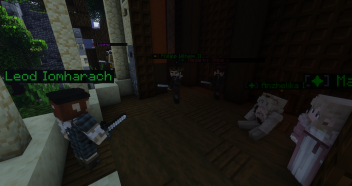
The first real challenge to Philipp’s rule came in the form of a thrust from within, as the general of the Hadrian armed forces, Leod Iomharach, was rumoured to have an affair with the Hadrian Empress. When the rumours reached the kaiser's court, the empress spoke to Emperor Philipp and explained where the rumours hailed from, though strongly rejected any of their truth. The Kaiser was enraged by this news and immediately summoned Leod to the Imperial Palace for questioning under the guise of a simple meeting regarding defensive matters. General Leod came to the palace as he had done many times before for he was considered a friend of the Imperial Family and of Emperor Philipp in particular. As Leod entered, he was led to the eastern balcony where Philipp after briefly playing as if they had a simple meeting and confronted Leod with the matter at hand. Leod attempted to deny any claims of having slept with the empress and simply expressed they were good friends. These words fell on deaf ears and Philipp had tremendous trouble controlling his anger towards his former best friend. Leod noticed that things were swiftly moving south and he decided to act first, in an act of impulse, he drew his sword on the Emperor and challenged him to single combat to resolve the matter. Philipp replied by drawing his own sword and the two were quickly clashing their swords on this balcony. The two friends both had lots of military experience, yet Leod was the better swordsman and as the fight went on, Philipp started to tire, leaving openings in his defense that were exploited by Leod, he slashed Philipp across the face, hitting his right eye and hacked him in the leg, rendering it useless. As the Emperor collapsed, the imperial guard led by Lady Judicar Ma Belov who heard the struggle outside finally broke down the door to the balcony that Philipp locked and saw the onslaught caused by the struggle. The entire balcony lay covered in blood and the Emperor sat blooded and beaten in the corner, yet still having his sword raised in defense against Leod. Ma and the Imperial Guards swiftly came to Philipp’s defense and cut down Leod, not killing him, but leaving him to die after a slash to the throat that made him collapse. This slash was delivered by Ma, who Leod refused to fight due to their personal relations. Ma though did not hesitate to put the man down, and as a single tear rolled down his cheek, Leod was beaten.
Philipp was swiftly taken care of by imperial medics who were able to save his life, though at great cost. The Emperor was now without a leg and missing an eye, crippled and weakened for the remainder of his life. This had a heavy mental toll on the Emperor for not only was the always agile Emperor now chairbound and missing his half his eyesight, he was also betrayed by those closest to him, his best friend and his wife. Most of the ambitious projects that the empire was working on came to almost a complete standstill as without the Emperor’s guidance and direct involvement, it was incredibly difficult to get the nobility and clergy to live by the new reforms. Leod never truly faced justice for his crimes as he was abandoned after being cut down. Yet, he was not mortally wounded and when he saw the opportunity, he lunged off the low-hanging balcony and fled Adelsburg, never to be seen again besides rumors of him having settled down in Anjyarr like many traitors of the Hadrian Crown before him.
Assassination of Philipp II (1532)
After Leod’s betrayel the Hadrian Empire had seen a relative time of peace within its borders. Yet otuside its borders it had taken up arms. Kaiser Philipp had ordered a war on Raevendrecht, and Hadriana was progressively gaining territory. To celebrate the victory in Flüssland, the Emperor organized a medal ceremony to honour those who fought in the battle and led the Hadrian army to victory. The ceremony was to be held in the Imperial Palace of Adelsburg. Both Hadrian officials and Helstein’s men were invited to take part in the celebration and ponder over the world that was to come after the war. Though in reality, the fate of both the war and Hadriana as a whole took a terrifying turn during this event.
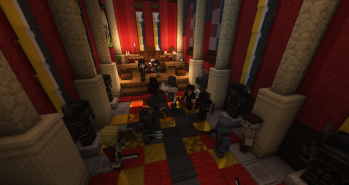
Not long before the celebration, Siegfried od Albion, Lord-Commander of the Hadrian army, and Sine Verrador, Head of the Imperial Duma, met with the leadership of Helstein’s order, convincing them that the Emperor was low on Andros and ordered the two to not pay the mercenaries for their hard work on the battlefield. A promise was made that if the mercenaries assisted the two in overtaking the reigns of the Empire, they would pay them double for their efforts, an offer the order gladly agreed to. In reality, both Sine and Siegfried had been conspiring to take the throne ever since the Emperor allowed Silas to walk free after his capture, resulting in many more lives lost for in their eyes nothing but personal glory for Philipp. They wished to rid themselves of Philipp, whose health had been declining for some time as both his old wounds and ever-increasing age started to catch up with him, crown-prince Karl, who they deemed weak and unfit to rule the empire, and the remainder of the living royal family, and so it was settled. The mercenaries and Imperial Army positioned themselves in the throne room where the ceremony was to be held and after Sine’s opening speech, all involved drew their swords. Sine was the first to strike and with a single thrust into Philipp’s chest, his life was ended. In his last moment, a singular tear rolled down his cheek as he realized that he was once again betrayed by his closest friends and allies, yet this time, the only way out was death. Crown Prince Karl, frightened by the sudden chaos, drew his sword in defense, this was then used to justify an attack against him. Siegfried approached the young prince from behind and with a singular blow to the neck, separated his head from his shoulders, leaving him dead as well.
The last man standing after the imperial guard was cut down was Ser Wyatt, a close friend and ally of the throne. While the imperial family and guard were cut down, he lunged himself at the traitors, cutting down eight of them before being overpowered and slain. The traitors moved quickly after they murdered everyone in the room and captured any loyalist noble and knight present in Adelsburg. Helstein’s armies rode out to the estates of said loyal nobles and knights and occupied their holdings. Most of the Imperial provinces were swiftly brought under Sine’s control, yet his search for the remaining Lichtenfelts was far from successful. While he managed to place Empress Anzhelika under house arrest in the imperial palace, the remaining three children were smuggled out of the city by loyalists, Helena and Hugo were brought to Luminion, while Katherina was smuggled into the Republic of Raevendrecht. Meanwhile, Philipp’s brother, Diederick-Göbel, was stationed in Castle Lünburg together with Lord Janczyck-Mariusz Tzyrnowski and did not attend the ceremony. When news reached them of what happened, Janczyck cursed at the usurper’s envoy who came to demand Janczyck’s loyalty and Diederick’s delivery to the capital. In response to the chaos, the last bastion of the loyalist faction split off from Hadriana, standing defiant against Sine’s new imperium.
Notable Buildings
The Imperial Palace
The Imperial Palace of Adelsburg is the seat of the ruling von Lichtenfelts dynasty now led by Kaiser Diederick I. Its construction was ordered around 1528 AFS by Kaiser Philipp II but was only finished under Diederick for there was a worker’s strike that hindered its completion for years. Only after Sine’s rebel forces were driven out of Adelsburg in 1534 AFS was its construction completed. The newly completed palace has many facilities for public events such as a lavish ballroom, throne hall, and gardens surrounding its main construction. The palace has seven bedrooms, two bathrooms, a coaching house, a guardhouse, a raven tower, and a handful of smaller offices and living quarters. A separate side wing of the Imperial Palace is dedicated to housing servants and teachers of the Imperial Family, acting as a small village in and of itself within the palace’s thick walls.
The Brandenburg
The castle on the southeastern corner of Adelsburg that towers over the area is known as the Brandenburg. The castle was constructed in 1534 - 1535 as part of Kaiser Diederick’s grand renovation of Adelsburg. The defensive structure holds a dungeon block, armory, many small offices, barracks, war horse stables, and a raven tower that doubles as the ErzCupbearer’s private office. The Brandenburg’s primary purpose is the house of the Reichsmarshall’s staff and acts as a base for the Reichsarmee.
The Grand Cathedral of Alder
Towering over the northern reaches of the Imperial Capital is the Grand Cathedral of Alder and its surrounding clerical district. It is the epicenter of the Alderist faith and the base of operations of the Vater and his personal guards and inquisitors. The Cathedral acts as a refuge for all who seek Alder and his Sentinels. The building itself is a huge diorite stone building decorated with many pillars and elaborate architectural marvels. The building is circular and held up by eight towers, each representing a Sentinel. The only one unrepresented is Dolus. The top of the Cathedral is topped off by a massive copper statue of Alder holding his sword.
The Imperial Crypts
Deep below the Grand Cathedral of Alder lie the Imperial Crypts where the remnants of the Imperial family members from Kaiser Matthias and on are buried. Their bodies are kept in crypts with fortified walls to keep any necromancer from using magic to manipulate them and a pair of specially assigned cultists of Mortius keep a constant eye on the graves.
Höfbrauhaus Brandenhafen
Standing proudly in the middle of Adelsburg Höfbrauhaus Brandenhafen is the biggest tavern of the Hadrian Empire. Having three entrances connected to three different squares, the tavern is accessible from wherever you come from. Upon entering, the beer maidens run around you as the bustling brauhaus is always busy providing alcoholic beverages and food to its customers. Having a large menu that includes imported drinks as well as locally brewed ones, such as Kronenbier, Alders Weissener and Brandhafen tripel, it is the place to visit during a stay at the Imperial Capital.
Notable figures living in Adelsburg
| Name | Portrait | Birth
Parentage |
Spouse(s)
Issue |
Status | Coat of Arms | Title(s) |
|---|---|---|---|---|---|---|
| Kaiser Diederick I | 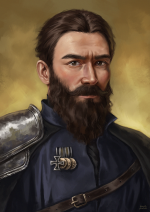
|
1492 AFS
Unknown |
Catherine✝, Veredra
Wilhelm, Karl, Sylvia |
Alive | 
|
Kaiser of Hadriana, Imperator et Attia
and Protector of the Realm |
| Kaiserin Veredra I | 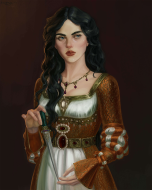
|
1514 AFS
Daughter of Frank Fischer |
Diederick-Gobel von Lichtenfelts
Wilhelm, Karl, Sylvia |
Alive | 
|
Kaiserin of Hadriana, ErzCupbearer |
| Vater Gregor I | 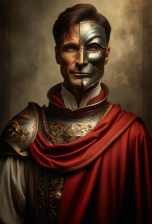
|
1501 AFS
Unknown |
none
none |
Alive | 
|
Vater of the Alderist Faith |
| Graf Friederich | 
|
1490 AFS
Unknown |
none
none |
Alive | 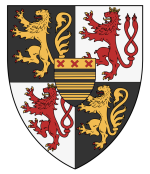
|
Graf of Dörne neben das Schwarzwald
Bürgermeister of Adelsburg, ErzTreasurer |
